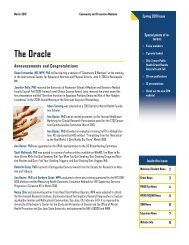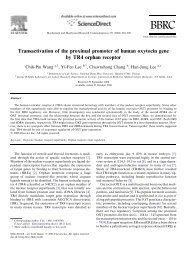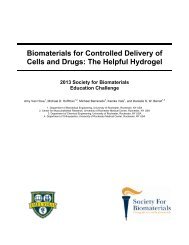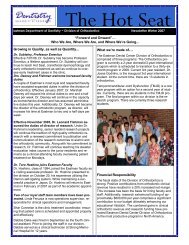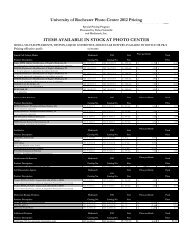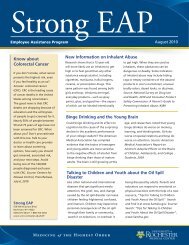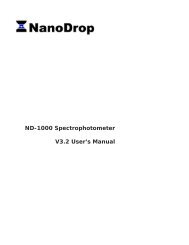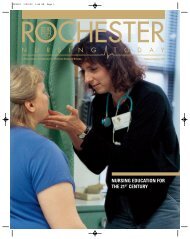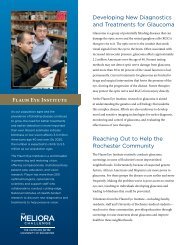Ethical Issues Related to Substance Abuse in Pregnancy ...
Ethical Issues Related to Substance Abuse in Pregnancy ...
Ethical Issues Related to Substance Abuse in Pregnancy ...
- No tags were found...
You also want an ePaper? Increase the reach of your titles
YUMPU automatically turns print PDFs into web optimized ePapers that Google loves.
Th e F<strong>in</strong>ger Lakes Regional Per<strong>in</strong>atal ForumToxic Exposures Dur<strong>in</strong>g <strong>Pregnancy</strong>Tuesday, June 8, 2010‐ Canandaigua, NY<strong>Ethical</strong> <strong>Issues</strong> <strong>Related</strong> <strong>to</strong> <strong>Substance</strong> <strong>Abuse</strong> <strong>in</strong> <strong>Pregnancy</strong>Presenter: Jane Greenlaw, JDF<strong>in</strong>d presentation at:http://www.urmc.rochester.edu/flrpp/forum/documents/<strong>Ethical</strong><strong>Issues</strong>.pdfCase example: Prenatal cl<strong>in</strong>ic <strong>in</strong> an urban university hospital where workers areconcerned about prenatal coca<strong>in</strong>e use (based on reports of postnatal observations).Plan is developed <strong>to</strong> “identify/assist pregnant patients suspected of drug abuse.”Positive results were reported <strong>to</strong> law enforcement. Women who tested positive were“referred” <strong>to</strong> substance abuse treatment.• Positive test prenatally – police notified and patient referred <strong>to</strong> treatment• Positive test postnatally – police notified and patient arrested immediatelyCharges:• 27 weeks or less: simple possession• 28 weeks or more: possession and distribution <strong>to</strong> “a person under 18”• If positive at delivery: above and unlawful neglect of a childOutcomes: Medical center violated the women’s 4 th Amendment protection aga<strong>in</strong>stunlawful searches s<strong>in</strong>ce they were tested without their knowledge or consent.What Went Wrong: Involvement of law enforcement agencies (creates adversarialsituation between caregivers and patients, chang<strong>in</strong>g the normal dynamic)New York State: Prenatal test<strong>in</strong>g should not be done without the woman’s knowledgeand consent.Rem<strong>in</strong>ders about pregnant women (generally). They will (are)• try harder than other patients <strong>to</strong> “follow doc<strong>to</strong>rs’ orders”• refra<strong>in</strong> from smok<strong>in</strong>g, dr<strong>in</strong>k<strong>in</strong>g, and try <strong>to</strong> eat well• accept medical recommendations even when not <strong>in</strong> their <strong>in</strong>terest• the most compliant<strong>Ethical</strong> stances:• The “patient au<strong>to</strong>nomy” approach• The “save the baby” approach• The “two patient” approachNeed for Intervention:• Medical, not legal, approach• Educate• Refer• Support• Encourage• Expect setbacks• Use established trust<strong>in</strong>g relationship• Don’t judgeFollow up comments/questions <strong>in</strong>cluded:• Mom, <strong>in</strong> another county, lost cus<strong>to</strong>dy of previous child due <strong>to</strong> substance abuse.Has not abused this pregnancy, yet CPS still says she can’t have cus<strong>to</strong>dy of child
from current pregnancy. CPS keeps upp<strong>in</strong>g the ante <strong>to</strong> keep mom from hav<strong>in</strong>gcus<strong>to</strong>dy.• Both drug rehab and jail work as treatment. Drug addicted mom needs <strong>to</strong> learn <strong>to</strong>live with addiction and at the same time learn <strong>to</strong> parent.• What do you do with mom who <strong>to</strong>tally denies that she uses? F<strong>in</strong>ds those momsvery difficult, frustrat<strong>in</strong>g <strong>to</strong> work with.• Jane Greenlaw: very frustrat<strong>in</strong>g s<strong>to</strong>ries <strong>to</strong> tell -- pregnancy after pregnancy --babies born impaired.Manag<strong>in</strong>g the Mentally IIl Pregnant PatientPresenter: Beth GoldenbergF<strong>in</strong>d presentation at:http://www.urmc.rochester.edu/flrpp/forum/documents/FAS.per<strong>in</strong>atalconf.pdf<strong>Substance</strong> <strong>Abuse</strong> and Dependence:• Drug addition is a complex bra<strong>in</strong> disease. It is characterized by compulsive, attimes, uncontrollable, drug crav<strong>in</strong>g, seek<strong>in</strong>g and use that persists even <strong>in</strong> theface of extremely negative consequences.• Drug seek<strong>in</strong>g becomes compulsive, <strong>in</strong> large part as a result of the effects ofprolonged drug use on bra<strong>in</strong> function<strong>in</strong>g and, thus, on behavior. For manypeople, drug addition becomes chronic, with relapses possible even after longperiods of abst<strong>in</strong>ence.Disorders with Increased Risks of Drug <strong>Abuse</strong>DisorderRiskAntisocial personality disorder 15.5%Manic episode 14.5%Schizophrenia 10.1%Panic disorder 4.3%Major depressive episode 4.1%Obsessive-compulsive disorder 3.4%Phobias 2.1%<strong>Substance</strong> <strong>Abuse</strong> <strong>in</strong> Pregnant Mentally Ill Women –Most commonly used drugs <strong>in</strong> pregnancy:Nicot<strong>in</strong>e 20%Alcohol 19%Marijuana 3%Coca<strong>in</strong>e 3%(National Institute of Drug <strong>Abuse</strong> (2002)<strong>Substance</strong> <strong>Abuse</strong> <strong>in</strong> Pregnant Women –Reasons why pregnant women usePrior his<strong>to</strong>ry of useLimited social supportIntimate partner violenceConcurrent mental illnessCase Study• Courtney, 36 yr. old Caucasian lesbian woman~advanced maternal age~active coca<strong>in</strong>e use~bipolar disorder• Pregnant as a result of her prostitution
~planned <strong>to</strong> term<strong>in</strong>ate pregnancy early on but partner, Marie, “talked me out ofit.”~on ultrasound, fetal heart showed Tetrology of Fallot but <strong>to</strong>o late for term<strong>in</strong>ation• Attendance at cl<strong>in</strong>ic was quite erratic~when she did come, she was typically high and very argumentative• Cont<strong>in</strong>ued <strong>to</strong> use coca<strong>in</strong>e through pregnancy and ended up <strong>in</strong> the hospital at 33weeks gestation due <strong>to</strong> premature rupture of membranes.~seen by Psychiatric Consultation Service while <strong>in</strong>patient <strong>to</strong> assist withmanagement of anxiety and demand<strong>in</strong>g behaviors.• Delivered son at 35 weeks gestation (<strong>in</strong>duced)~asked at time of discharge <strong>to</strong> be referred <strong>to</strong> outpatient mental health care andchemical dependency treatment.Fetal Alcohol Syndrome and Long Term Developmental EffectsPresenter: Nirupama LaroiaF<strong>in</strong>d presentation at:http://www.urmc.rochester.edu/flrpp/forum/documents/Mentalillnessandsubstanceuse.pdfHis<strong>to</strong>ry of Alcohol Consumption and Pregnant Women reviewed• As early as 330 BC Aris<strong>to</strong>tle noted “Foolish drunken and hair bra<strong>in</strong>ed womenmost often br<strong>in</strong>g forth children like un<strong>to</strong> themselves, morose and languid.” Inancient Sparta and Carthage, cus<strong>to</strong>m prohibited newlyweds from dr<strong>in</strong>k<strong>in</strong>g ontheir wedd<strong>in</strong>g night <strong>in</strong> order <strong>to</strong> prevent conceiv<strong>in</strong>g a “damaged” child.• The association of alcohol with poor birth outcomes cont<strong>in</strong>ued until the end ofprohibition (1920-1933) when some felt that the idea was propaganda circulatedby proponents of prohibition. Mid-1930s -- some doc<strong>to</strong>rs reassured pregnantpatients that a dr<strong>in</strong>k or two daily was OK as a means of relax<strong>in</strong>g.• 1950s – Alcohol use among pregnant women rose – few worried about theeffects on the newborn.• 1968 – French scientists track<strong>in</strong>g 127 children born <strong>to</strong> alcoholic mothers found aseries of effects that they blame on <strong>in</strong>-utero exposure <strong>to</strong> alcohol.• 1973 – Lancet reported the work of scientists from the University of Wash<strong>in</strong>g<strong>to</strong>nwho studied <strong>in</strong>fants born <strong>to</strong> alcoholic mothers. Named it “fetal alcohol syndrome(FAS).”FAS Diagnostic Criteria• Characteristic pattern of facial anomalies• Growth restriction• Central nervous system neurodevelopmental abnormalities• Known his<strong>to</strong>ry of maternal alcohol consumptionHow Alcohol Does its Damage• Alcohol passes easily across the placenta• Fetal levels rise above maternal levels• Fetal liver is <strong>in</strong>efficient, maternal liver must do the work for both• Alcohol is metabolized <strong>to</strong> acetaldehyde <strong>in</strong> the liver• Interference with fetal nutritionWhat is Know – What Rema<strong>in</strong>s Uncerta<strong>in</strong>?• Incidence 0.5-2.0/1000 births~considerable <strong>in</strong>ternational variation <strong>in</strong> estimates• Consistent effects of high dose of alcohol~multiple mechanisms depend<strong>in</strong>g on dose, pattern and tim<strong>in</strong>g
• Animal models suggest neurologic effects with low <strong>to</strong> moderate exposure• Tip of the iceberg – alcohol related neurodevelopmental disorder~<strong>in</strong>cident of 10/1000 live births~absent facial features~structural bra<strong>in</strong> abnormalities with confirmed maternal alcohol exposureBarriers <strong>to</strong> Adequate Counsel<strong>in</strong>g• Concern about label<strong>in</strong>g, difficulties <strong>in</strong> mak<strong>in</strong>g a causal attribution <strong>to</strong> prenatalalcohol• Lack of consensus <strong>in</strong> the literature, skeptic physicians• Lack of awareness and knowledge among cl<strong>in</strong>icians• Are physicians miss<strong>in</strong>g an important diagnosis with important implications forprevention?Important Research Questions• Does the pattern of alcohol consumption matter?• Threshold level of alcohol consumption?• Tim<strong>in</strong>g of consumption dur<strong>in</strong>g pregnancy matter?• Other predictive fac<strong>to</strong>rs• One or several phenotypes? Associations with other psychiatric disorders?Prevention of Alcohol Induced Fetal Damage• 2000, AAP Committee on <strong>Substance</strong> <strong>Abuse</strong> published the follow<strong>in</strong>grecommendations:~abst<strong>in</strong>ence is recommended for pregnant women and for those plann<strong>in</strong>gpregnancy~high quality educational programs should be developed for all levels ofsociety regard<strong>in</strong>g the deleterious effects of alcohol on the unborn child.~health care professionals should <strong>in</strong>crease their own awareness of FASand ARND and their prevention~AAP supports federal legislation requir<strong>in</strong>g <strong>in</strong>clusion of health andsafety messages <strong>in</strong> all alcohol advertis<strong>in</strong>g~parents of affected children should receive appropriate support servicesfor themselves and their childrenNeonatal Alcohol Withdrawal is often overlooked, but importantIs There an Answer?• Abst<strong>in</strong>ence• Discuss risk dur<strong>in</strong>g pregnancyDaystar – New York State’s First and Only Day and Respite Program for MedicallyFragile InfantsPresenter: Natalie AndersonTo learn more about Daystar: www.daystarsj.orgFounded by the Sisters of St. Joseph <strong>in</strong> 1988 as a foster home for medically fragile<strong>in</strong>fants, Daystar fills an unmet need <strong>to</strong> provide safe, quality care for this population –a need that cont<strong>in</strong>ues <strong>to</strong>day as medical advances save the lives of children who <strong>in</strong> thepast would not have survived.In 2001, doc<strong>to</strong>rs <strong>in</strong> the neo-natal <strong>in</strong>tensive care unit at the Golisano Children’s Hospitalat Strong urged Daystar <strong>to</strong> expand it services <strong>to</strong> provide medical daycare – first for twobabies, and follow<strong>in</strong>g an expansion of our current home, for 10 babies per day. As alicensed Group Family Day Care under the NYS Office of Children and Family Services(OCFS), we can serve no more than 10 babies at a time.
Daystar is dedicated <strong>to</strong> support<strong>in</strong>g our community’s most vulnerable <strong>in</strong>fants fromnewborns <strong>to</strong> three-year-olds by provid<strong>in</strong>g quality childcare, respite care, advocacy, andfamily support <strong>in</strong> a safe and stimulat<strong>in</strong>g home environment. Daystar is the first and onlyprogram <strong>in</strong> NYS <strong>to</strong> offer this type of service. Daystar families receive essentialguidance, education, and support <strong>in</strong> fac<strong>in</strong>g the multiple challenges of rais<strong>in</strong>g a child withmedical and developmental complexities. Daystar is a publicly supported non-profi<strong>to</strong>rganization.Awarded a NYS grant through OCFS, Daystar has been able <strong>to</strong> develop and formalizethe <strong>in</strong>puts necessary <strong>to</strong> deliver medical daycare <strong>to</strong> populations with significant andcomplex medical and developmental fac<strong>to</strong>rs. Daystar’s comprehensive collaborative,pioneer<strong>in</strong>g research and development <strong>in</strong>itiative has yielded the Best Practices ChildCare Program and Environment for car<strong>in</strong>g for medical fragile <strong>in</strong>fants.Please note:• Space is very limited. Interested parents should contact Daystar as soon as needis identified as there is a long wait<strong>in</strong>g list.• Both part time and full time care is offered.



